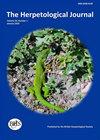Carry-over effects of the larval environment on the post-metamorphic performance of Bombina variegata (Amphibia, Anura)
IF 1.1
4区 生物学
Q3 ZOOLOGY
引用次数: 11
Abstract
Metamorphs of the yellow-bellied toad, Bombina variegata, vary widely in size at metamorphosis in the field. We performed a replicated outdoor mesocosm study to simulate the environmental factor combinations in permanent and ephemeral breeding sites and to quantify their effects on tadpole development (duration of the larval period, metamorph size and body condition). Looking for potential carry-over effects of the larval environment, we quantified locomotor performance of all metamorph phenotypes originating from the mesocosms immediately after metamorphosis under controlled conditions. In contrast to the prediction of life-history theory, tadpoles were unable to adjust developmental rate to water availability, but metamorphs originating from the ephemeral pond treatment were smaller and had a lower body condition than those from the permanent pond treatment. Size-dependent carry-over effects included the length of the first jump following tactile stimulation, burst performance (total length of spontaneous jumps) and endurance (total distance covered in 10 forced jumps). A size-independent effect of larval environment was the prolonged locomotor effort to escape (5.7 consecutive jumps following initial stimulus) of metamorphs from the ephemeral pond treatment compared to same-sized ones (3.7 jumps) from the permanent pond treatment. Thus, we demonstrate that carry-over effects of larval environment on metamorph phenotype and behaviour cause a considerable variation in fitness in the early terrestrial stage of B. variegata. Informed conservation management of endangered populations in the northern range should therefore include the provision of small permanent breeding ponds promoting larger and fitter metamorphs.幼虫环境对杂交蟹(两栖纲、无尾纲)变质后性能的携带效应
黄腹蟾蜍的变形,bomina variegata,在野外变形时大小差别很大。我们进行了一项重复的室外中生态研究,以模拟永久和短暂繁殖地的环境因素组合,并量化它们对蝌蚪发育的影响(幼虫期持续时间、蜕变大小和身体状况)。为了寻找幼虫环境的潜在携带效应,我们在受控条件下量化了所有源自中胚层的蜕变表型在蜕变后的运动表现。与生活史理论的预测相反,蝌蚪的发育速度不能根据水的可用性进行调整,但短期池塘处理产生的变质体比长期池塘处理产生的变质体更小,体况更低。大小相关的携带效应包括触觉刺激后第一次跳跃的长度,爆发表现(自发跳跃的总长度)和耐力(10次强制跳跃的总距离)。一个与大小无关的环境效应是,与长期池塘处理的相同大小的幼虫(3.7次跳跃)相比,短期池塘处理的变质幼虫(5.7次连续跳跃)为逃离而付出的运动努力更长。因此,我们证明了幼虫环境对变异表型和行为的携带效应导致了斑叶小蠊早期陆地阶段适应度的相当大的变化。因此,对北部地区濒危种群的知情保护管理应包括提供小型永久性繁殖池塘,促进更大、更健康的变质。
本文章由计算机程序翻译,如有差异,请以英文原文为准。
求助全文
约1分钟内获得全文
求助全文
来源期刊

Herpetological Journal
生物-动物学
CiteScore
2.40
自引率
10.00%
发文量
25
审稿时长
>12 weeks
期刊介绍:
The Herpetological Journal is the Society''s prestigious quarterly scientific journal.
 求助内容:
求助内容: 应助结果提醒方式:
应助结果提醒方式:


